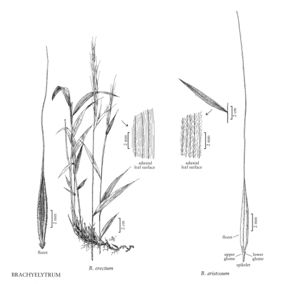Difference between revisions of "Brachyelytrum erectum"
FNA>Volume Importer |
imported>Volume Importer |
||
| (7 intermediate revisions by 2 users not shown) | |||
| Line 4: | Line 4: | ||
|publications= | |publications= | ||
|common_names=Southern shorthusk;Brachyelytrum dresse | |common_names=Southern shorthusk;Brachyelytrum dresse | ||
| + | |special_status={{Treatment/ID/Special_status | ||
| + | |code=E | ||
| + | |label=Endemic | ||
| + | }} | ||
|basionyms= | |basionyms= | ||
|synonyms={{Treatment/ID/Synonym | |synonyms={{Treatment/ID/Synonym | ||
|name=Brachyelytrum aristosum var. glabratum | |name=Brachyelytrum aristosum var. glabratum | ||
| − | |authority= | + | |authority= |
| + | |rank=variety | ||
}} | }} | ||
|hierarchy=Poaceae;Poaceae subfam. Pooideae;Poaceae tribe Brachyelytreae;Brachyelytrum;Brachyelytrum erectum | |hierarchy=Poaceae;Poaceae subfam. Pooideae;Poaceae tribe Brachyelytreae;Brachyelytrum;Brachyelytrum erectum | ||
| Line 19: | Line 24: | ||
-->{{Treatment/Body | -->{{Treatment/Body | ||
| − | |distribution=Conn.;N.J.;N.Y.;W.Va.;Del.;D.C;Wis.;Iowa;Fla.;Puerto Rico;Mass.;R.I.;Tex.;La.;Kans.;Nebr.;Tenn.;N.C.;S.C.;Pa.;Va.;Ala.;Ark.;Ill.;Ga.;Ind.;N.B.;Nfld. | + | |distribution=Conn.;N.J.;N.Y.;W.Va.;Del.;D.C.;Wis.;Iowa;Fla.;Puerto Rico;Mass.;R.I.;Tex.;La.;Kans.;Nebr.;Tenn.;N.C.;S.C.;Pa.;Va.;Ala.;Ark.;Ill.;Ga.;Ind.;N.B.;Nfld. and Labr. (Labr.);N.S.;Ont.;Que.;Okla.;Md.;Ohio;Mo.;Minn.;Mich.;Miss.;Ky. |
|discussion=<p><i>Brachyelytrum erectum</i> grows in woodlands, occasionally over limestone bedrock, and in moist woods and forests. It extends from Lake of the Woods, Ontario, east to Newfoundland, and in the United States from Minnesota to New England and south to the Gulf Coast and Florida.</p><!-- | |discussion=<p><i>Brachyelytrum erectum</i> grows in woodlands, occasionally over limestone bedrock, and in moist woods and forests. It extends from Lake of the Woods, Ontario, east to Newfoundland, and in the United States from Minnesota to New England and south to the Gulf Coast and Florida.</p><!-- | ||
--><p>Koyama and Kawano (1964), among others, treated <i>Brachyelytrum erectum</i> <i></i>var.<i> glabratum</i> (Vasey) T. Koyama & Kawano as the northern taxon <i>B. aristosum</i>, but the holotype of <i>B. erectum</i> <i></i>var.<i> glabratum</i> belongs to <i>B. erectum</i> sensu stricto. This means that, nomenclaturally, <i>B. erectum</i> <i></i>var.<i> glabratum</i> is a synonym of <i>B. erectum</i>, although most of the specimens identified as <i></i>var.<i> glabratum</i> belong to <i>B. aristosum</i>.</p> | --><p>Koyama and Kawano (1964), among others, treated <i>Brachyelytrum erectum</i> <i></i>var.<i> glabratum</i> (Vasey) T. Koyama & Kawano as the northern taxon <i>B. aristosum</i>, but the holotype of <i>B. erectum</i> <i></i>var.<i> glabratum</i> belongs to <i>B. erectum</i> sensu stricto. This means that, nomenclaturally, <i>B. erectum</i> <i></i>var.<i> glabratum</i> is a synonym of <i>B. erectum</i>, although most of the specimens identified as <i></i>var.<i> glabratum</i> belong to <i>B. aristosum</i>.</p> | ||
| Line 30: | Line 35: | ||
-->{{#Taxon: | -->{{#Taxon: | ||
name=Brachyelytrum erectum | name=Brachyelytrum erectum | ||
| − | |||
|authority=(Schreb.) P. Beauv. | |authority=(Schreb.) P. Beauv. | ||
|rank=species | |rank=species | ||
| Line 37: | Line 41: | ||
|basionyms= | |basionyms= | ||
|family=Poaceae | |family=Poaceae | ||
| − | |distribution=Conn.;N.J.;N.Y.;W.Va.;Del.;D.C;Wis.;Iowa;Fla.;Puerto Rico;Mass.;R.I.;Tex.;La.;Kans.;Nebr.;Tenn.;N.C.;S.C.;Pa.;Va.;Ala.;Ark.;Ill.;Ga.;Ind.;N.B.;Nfld. | + | |illustrator=Linda Ann Vorobik |
| + | |illustration copyright=Utah State University | ||
| + | |distribution=Conn.;N.J.;N.Y.;W.Va.;Del.;D.C.;Wis.;Iowa;Fla.;Puerto Rico;Mass.;R.I.;Tex.;La.;Kans.;Nebr.;Tenn.;N.C.;S.C.;Pa.;Va.;Ala.;Ark.;Ill.;Ga.;Ind.;N.B.;Nfld. and Labr. (Labr.);N.S.;Ont.;Que.;Okla.;Md.;Ohio;Mo.;Minn.;Mich.;Miss.;Ky. | ||
|reference=None | |reference=None | ||
|publication title= | |publication title= | ||
|publication year= | |publication year= | ||
| − | |special status= | + | |special status=Endemic |
| − | |source xml=https:// | + | |source xml=https://bitbucket.org/aafc-mbb/fna-data-curation/src/200273ad09963decb8fc72550212de541d86569d/coarse_grained_fna_xml/V24/V24_66.xml |
|subfamily=Poaceae subfam. Pooideae | |subfamily=Poaceae subfam. Pooideae | ||
|tribe=Poaceae tribe Brachyelytreae | |tribe=Poaceae tribe Brachyelytreae | ||
Latest revision as of 16:24, 11 May 2021
Culms 34-102 cm long, 0.7-1.4 mm thick, erect; nodes densely pilose; lowest internodes mostly glabrous, usually retrorsely pub¬escent near the nodes. Sheaths hispid; ligules of middle and upper cauline blades 2-3.5 mm, truncate to acute, lacerate or erose; blades 8.8-17.5 cm long, (9)11-17(20) mm wide, abaxial surfaces pilose on the veins and often between the veins, adaxial surfaces glabrous or slightly hispid, margins scabrous, with (2)5-11(14) prickles and 0-2(14) macrohairs per mm. Panicles (5.5)9.1-14.3(18.5) cm. Spikelets, including the awns, (25)29-36(42) mm. Lower glumes (0.1)0.3-0.7(1.1) mm, sometimes absent; upper glumes (0.2)0.9-3.5(7) mm, sometimes aristate; calluses hairy, hairs 0.2-0.5 mm; lemmas 9-13 mm long, 0.8-1.7 mm wide, veins hispid, hairs 0.2-0.9 mm, midveins more prominent than the lateral veins; awns 13-17(20) mm; paleas 7-12 mm; anthers 3.5-6 mm. Caryopses 5.5-7.5 mm. 2n = 22.
Distribution
Conn., N.J., N.Y., W.Va., Del., D.C., Wis., Iowa, Fla., Puerto Rico, Mass., R.I., Tex., La., Kans., Nebr., Tenn., N.C., S.C., Pa., Va., Ala., Ark., Ill., Ga., Ind., N.B., Nfld. and Labr. (Labr.), N.S., Ont., Que., Okla., Md., Ohio, Mo., Minn., Mich., Miss., Ky.
Discussion
Brachyelytrum erectum grows in woodlands, occasionally over limestone bedrock, and in moist woods and forests. It extends from Lake of the Woods, Ontario, east to Newfoundland, and in the United States from Minnesota to New England and south to the Gulf Coast and Florida.
Koyama and Kawano (1964), among others, treated Brachyelytrum erectum var. glabratum (Vasey) T. Koyama & Kawano as the northern taxon B. aristosum, but the holotype of B. erectum var. glabratum belongs to B. erectum sensu stricto. This means that, nomenclaturally, B. erectum var. glabratum is a synonym of B. erectum, although most of the specimens identified as var. glabratum belong to B. aristosum.
Selected References
None.
